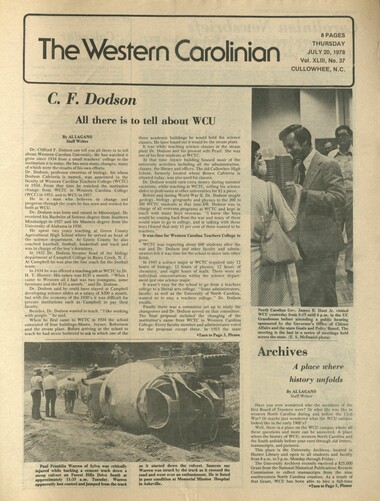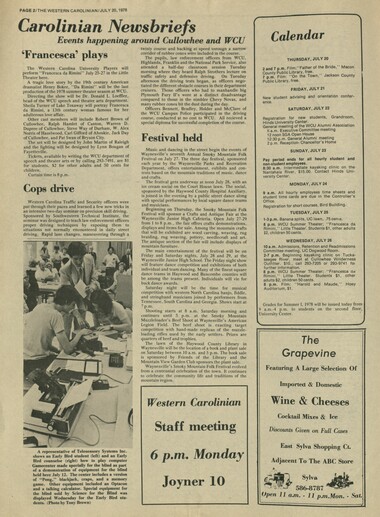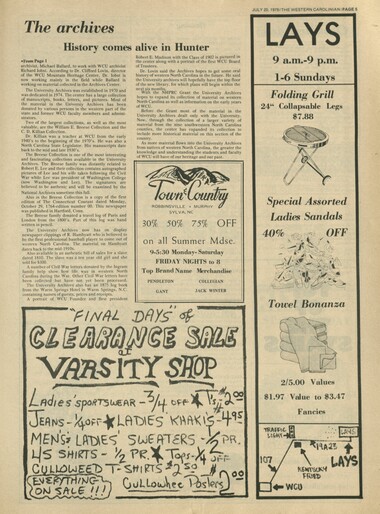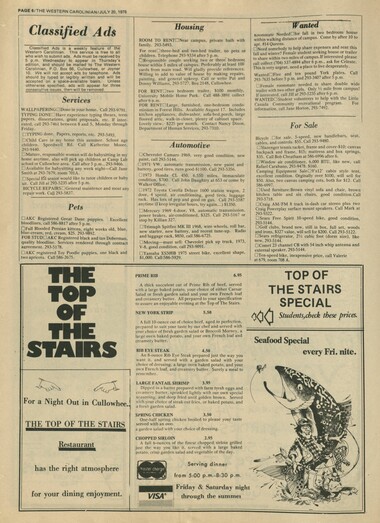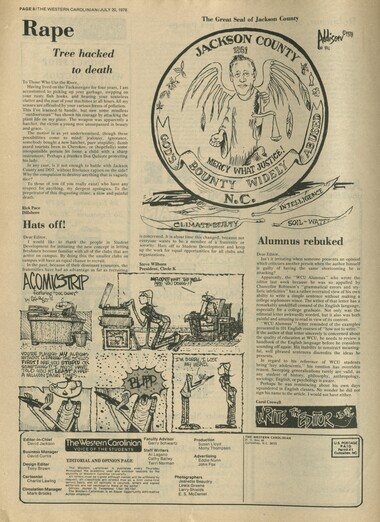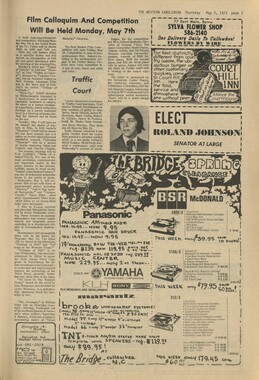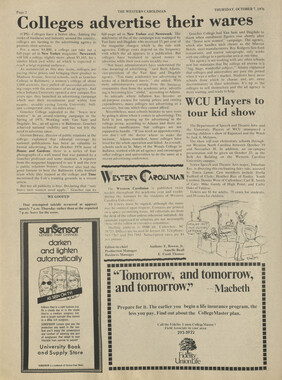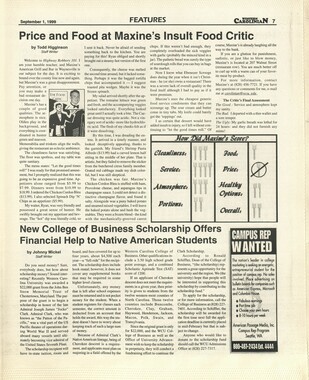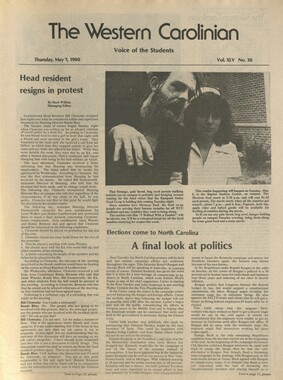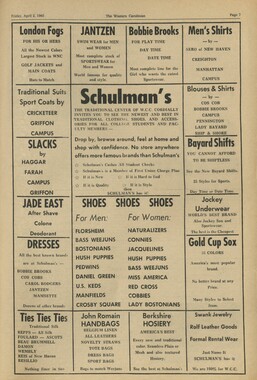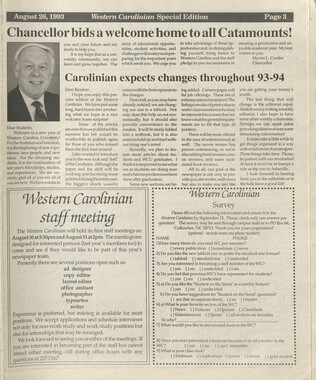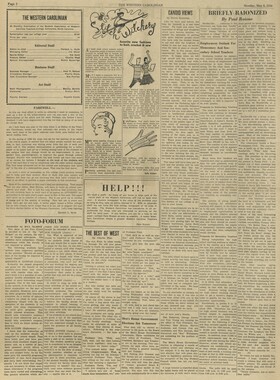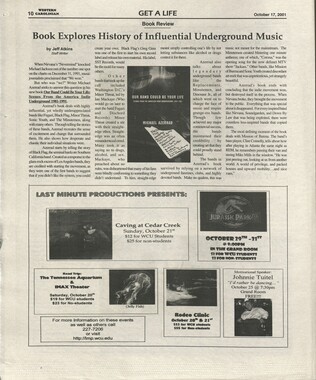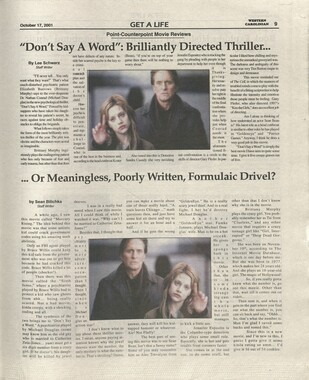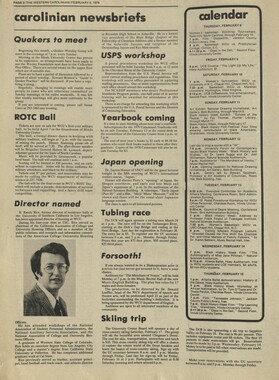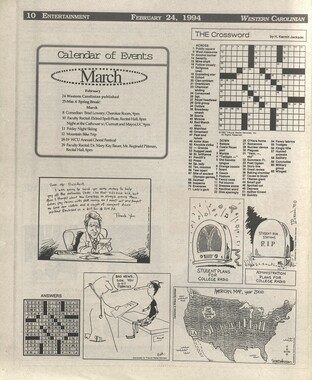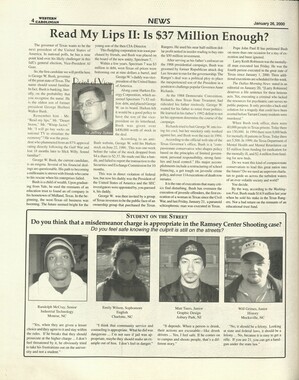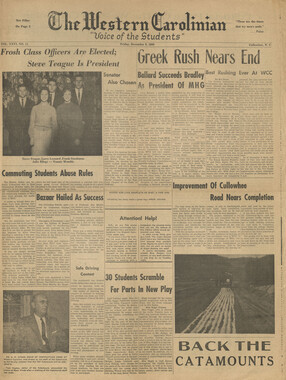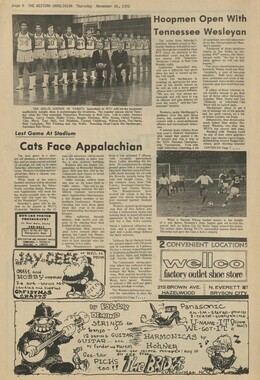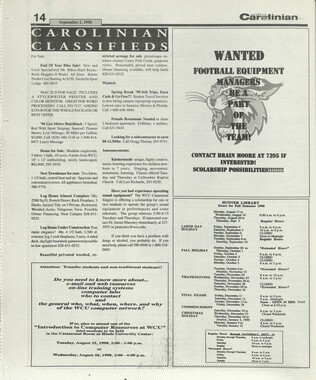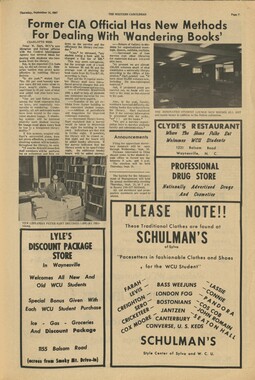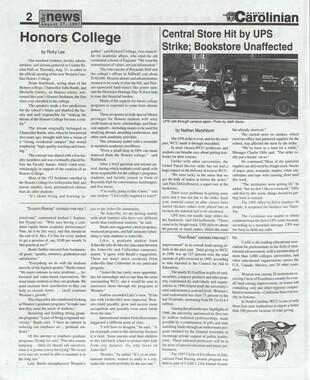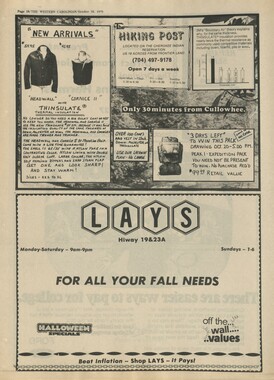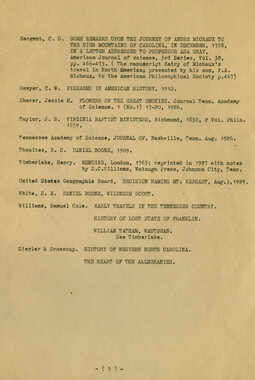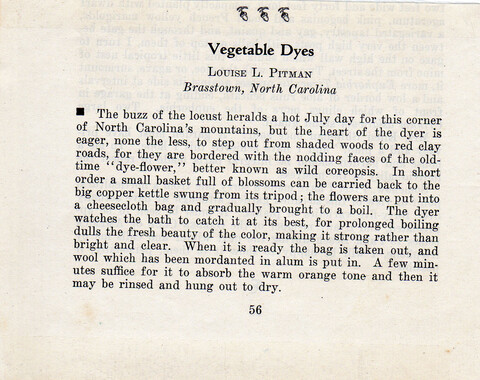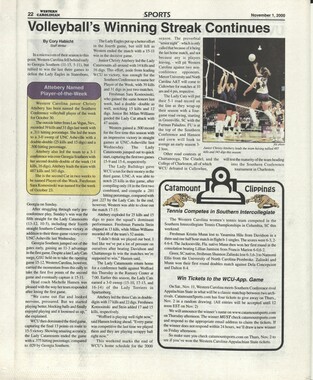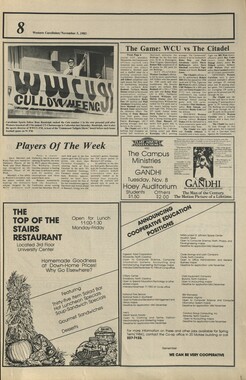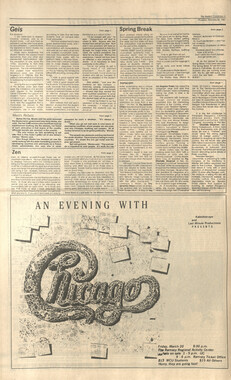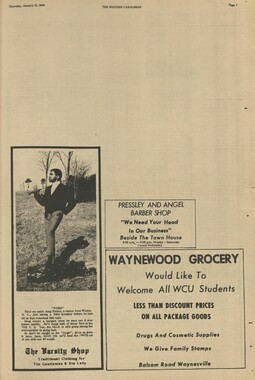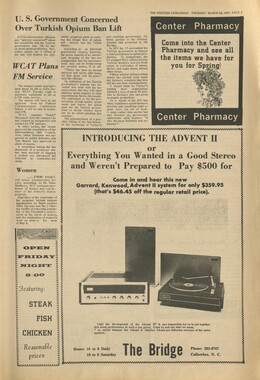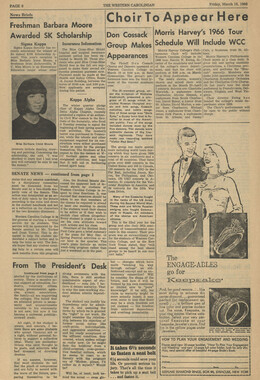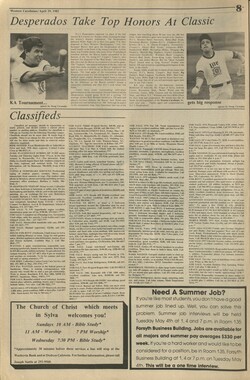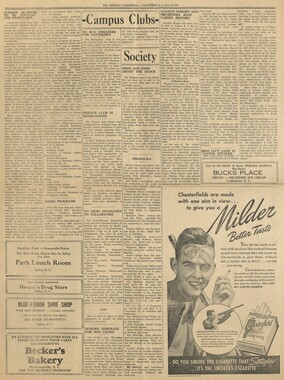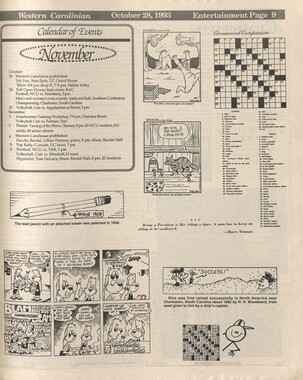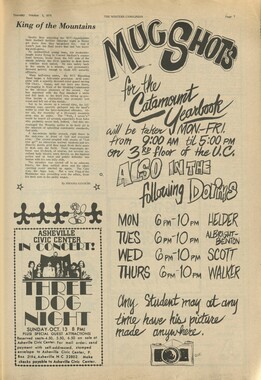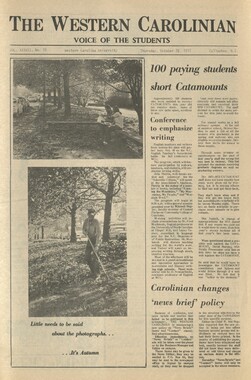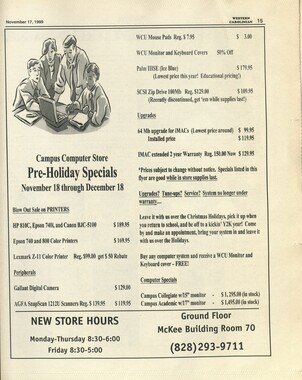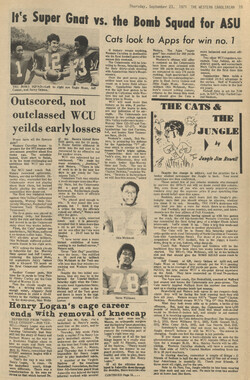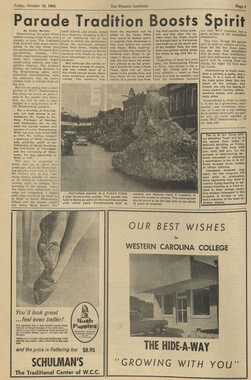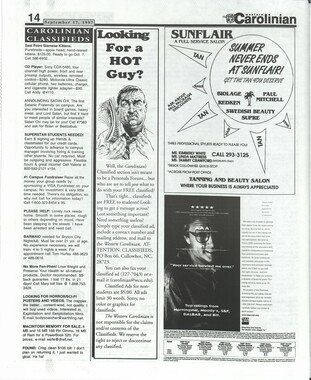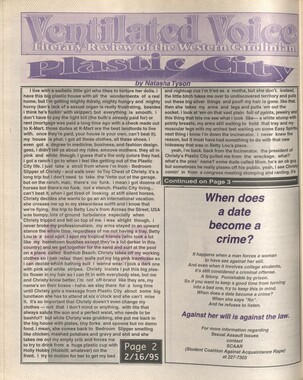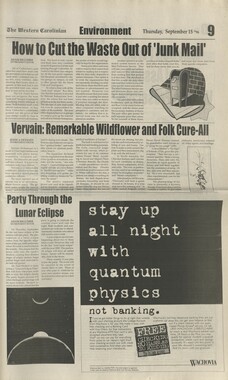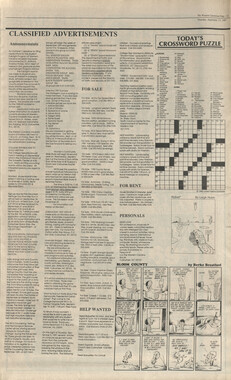Western Carolina University (20)
View all
- Canton Champion Fibre Company (2308)
- Cherokee Traditions (293)
- Civil War in Southern Appalachia (165)
- Craft Revival (1942)
- Great Smoky Mountains - A Park for America (2767)
- Highlights from Western Carolina University (430)
- Horace Kephart (941)
- Journeys Through Jackson (154)
- LGBTQIA+ Archive of Jackson County (24)
- Oral Histories of Western North Carolina (314)
- Picturing Appalachia (6772)
- Stories of Mountain Folk (413)
- Travel Western North Carolina (160)
- Western Carolina University Fine Art Museum Vitreograph Collection (129)
- Western Carolina University Herbarium (92)
- Western Carolina University: Making Memories (708)
- Western Carolina University Publications (2283)
- Western Carolina University Restricted Electronic Theses and Dissertations (146)
- Western North Carolina Regional Maps (71)
- World War II in Southern Appalachia (131)
University of North Carolina Asheville (6)
View all
- Allanstand Cottage Industries (62)
- Appalachian National Park Association (53)
- Bennett, Kelly, 1890-1974 (1388)
- Berry, Walter (76)
- Brasstown Carvers (40)
- Carver, George Washington, 1864?-1943 (26)
- Cathey, Joseph, 1803-1874 (1)
- Champion Fibre Company (233)
- Champion Paper and Fibre Company (297)
- Cherokee Indian Fair Association (16)
- Cherokee Language Program (22)
- Crowe, Amanda (40)
- Edmonston, Thomas Benton, 1842-1907 (7)
- Ensley, A. L. (Abraham Lincoln), 1865-1948 (275)
- Fromer, Irving Rhodes, 1913-1994 (70)
- George Butz (BFS 1907) (46)
- Goodrich, Frances Louisa (120)
- Grant, George Alexander, 1891-1964 (96)
- Heard, Marian Gladys (60)
- Kephart, Calvin, 1883-1969 (15)
- Kephart, Horace, 1862-1931 (313)
- Kephart, Laura, 1862-1954 (39)
- Laney, Gideon Thomas, 1889-1976 (439)
- Masa, George, 1881-1933 (61)
- McElhinney, William Julian, 1896-1953 (44)
- Niggli, Josephina, 1910-1983 (10)
- North Carolina Park Commission (105)
- Osborne, Kezia Stradley (9)
- Owens, Samuel Robert, 1918-1995 (11)
- Penland Weavers and Potters (36)
- Roberts, Vivienne (15)
- Roth, Albert, 1890-1974 (142)
- Schenck, Carl Alwin, 1868-1955 (1)
- Sherrill's Photography Studio (2565)
- Southern Highland Handicraft Guild (127)
- Southern Highlanders, Inc. (71)
- Stalcup, Jesse Bryson (46)
- Stearns, I. K. (213)
- Thompson, James Edward, 1880-1976 (226)
- United States. Indian Arts and Crafts Board (130)
- USFS (683)
- Vance, Zebulon Baird, 1830-1894 (1)
- Weaver, Zebulon, 1872-1948 (58)
- Western Carolina College (230)
- Western Carolina Teachers College (282)
- Western Carolina University (1794)
- Western Carolina University. Mountain Heritage Center (18)
- Whitman, Walt, 1819-1892 (10)
- Wilburn, Hiram Coleman, 1880-1967 (73)
- Williams, Isadora (3)
- Cain, Doreyl Ammons (0)
- Crittenden, Lorraine (0)
- Rhodes, Judy (0)
- Smith, Edward Clark (0)
- Appalachian Region, Southern (2393)
- Asheville (N.C.) (1887)
- Avery County (N.C.) (26)
- Blount County (Tenn.) (161)
- Buncombe County (N.C.) (1664)
- Cherokee County (N.C.) (283)
- Clay County (N.C.) (555)
- Graham County (N.C.) (233)
- Great Smoky Mountains National Park (N.C. and Tenn.) (505)
- Haywood County (N.C.) (3522)
- Henderson County (N.C.) (70)
- Jackson County (N.C.) (4692)
- Knox County (Tenn.) (25)
- Knoxville (Tenn.) (12)
- Lake Santeetlah (N.C.) (10)
- Macon County (N.C.) (420)
- Madison County (N.C.) (211)
- McDowell County (N.C.) (39)
- Mitchell County (N.C.) (132)
- Polk County (N.C.) (35)
- Qualla Boundary (981)
- Rutherford County (N.C.) (76)
- Swain County (N.C.) (2113)
- Transylvania County (N.C.) (247)
- Watauga County (N.C.) (12)
- Waynesville (N.C.) (68)
- Yancey County (N.C.) (72)
- Aerial Photographs (3)
- Aerial Views (60)
- Albums (books) (4)
- Articles (1)
- Artifacts (object Genre) (228)
- Bibliographies (1)
- Biography (general Genre) (2)
- Cards (information Artifacts) (38)
- Clippings (information Artifacts) (191)
- Crafts (art Genres) (622)
- Depictions (visual Works) (21)
- Design Drawings (1)
- Drawings (visual Works) (184)
- Envelopes (73)
- Facsimiles (reproductions) (1)
- Fiction (general Genre) (4)
- Financial Records (12)
- Fliers (printed Matter) (67)
- Glass Plate Negatives (381)
- Guidebooks (2)
- Internegatives (10)
- Interviews (811)
- Land Surveys (102)
- Letters (correspondence) (1013)
- Manuscripts (documents) (619)
- Maps (documents) (174)
- Memorandums (25)
- Minutes (administrative Records) (59)
- Negatives (photographs) (5835)
- Newsletters (1285)
- Newspapers (2)
- Occupation Currency (1)
- Paintings (visual Works) (1)
- Pen And Ink Drawings (1)
- Periodicals (193)
- Personal Narratives (7)
- Photographs (12976)
- Plans (maps) (1)
- Poetry (7)
- Portraits (1802)
- Postcards (329)
- Programs (documents) (151)
- Publications (documents) (2237)
- Questionnaires (65)
- Scrapbooks (282)
- Sheet Music (1)
- Slides (photographs) (402)
- Sound Recordings (796)
- Specimens (92)
- Speeches (documents) (15)
- Tintypes (photographs) (8)
- Transcripts (322)
- Video Recordings (physical Artifacts) (23)
- Vitreographs (129)
- Text Messages (0)
- A.L. Ensley Collection (275)
- Appalachian Industrial School Records (7)
- Appalachian National Park Association Records (336)
- Axley-Meroney Collection (2)
- Bayard Wootten Photograph Collection (20)
- Bethel Rural Community Organization Collection (7)
- Blumer Collection (5)
- C.W. Slagle Collection (20)
- Canton Area Historical Museum (2110)
- Carlos C. Campbell Collection (282)
- Cataloochee History Project (65)
- Cherokee Studies Collection (4)
- Daisy Dame Photograph Album (5)
- Daniel Boone VI Collection (1)
- Doris Ulmann Photograph Collection (112)
- Elizabeth H. Lasley Collection (1)
- Elizabeth Woolworth Szold Fleharty Collection (4)
- Frank Fry Collection (95)
- George Masa Collection (173)
- Gideon Laney Collection (452)
- Hazel Scarborough Collection (2)
- Hiram C. Wilburn Papers (28)
- Historic Photographs Collection (236)
- Horace Kephart Collection (861)
- Humbard Collection (33)
- Hunter and Weaver Families Collection (1)
- I. D. Blumenthal Collection (4)
- Isadora Williams Collection (4)
- Jesse Bryson Stalcup Collection (47)
- Jim Thompson Collection (224)
- John B. Battle Collection (7)
- John C. Campbell Folk School Records (80)
- John Parris Collection (6)
- Judaculla Rock project (2)
- Kelly Bennett Collection (1407)
- Love Family Papers (11)
- Major Wiley Parris Civil War Letters (3)
- Map Collection (12)
- McFee-Misemer Civil War Letters (34)
- Mountain Heritage Center Collection (4)
- Norburn - Robertson - Thomson Families Collection (44)
- Pauline Hood Collection (7)
- Pre-Guild Collection (2)
- Qualla Arts and Crafts Mutual Collection (12)
- R.A. Romanes Collection (681)
- Rosser H. Taylor Collection (1)
- Samuel Robert Owens Collection (94)
- Sara Madison Collection (144)
- Sherrill Studio Photo Collection (2558)
- Smoky Mountains Hiking Club Collection (616)
- Stories of Mountain Folk - Radio Programs (374)
- The Reporter, Western Carolina University (510)
- Venoy and Elizabeth Reed Collection (16)
- WCU Gender and Sexuality Oral History Project (32)
- WCU Mountain Heritage Center Oral Histories (25)
- WCU Oral History Collection - Mountain People, Mountain Lives (71)
- WCU Students Newspapers Collection (1744)
- Western North Carolina Tomorrow Black Oral History Project (69)
- William Williams Stringfield Collection (2)
- Zebulon Weaver Collection (109)
- African Americans (390)
- Appalachian Trail (35)
- Artisans (521)
- Cherokee art (84)
- Cherokee artists -- North Carolina (10)
- Cherokee language (21)
- Cherokee pottery (101)
- Cherokee women (208)
- Church buildings (167)
- Civilian Conservation Corps (U.S.) (110)
- College student newspapers and periodicals (1830)
- Dams (103)
- Dance (1023)
- Education (222)
- Floods (61)
- Folk music (1015)
- Forced removal, 1813-1903 (2)
- Forest conservation (220)
- Forests and forestry (917)
- Gender nonconformity (4)
- Great Smoky Mountains National Park (N.C. and Tenn.) (181)
- Hunting (38)
- Landscape photography (10)
- Logging (103)
- Maps (84)
- Mines and mineral resources (8)
- North Carolina -- Maps (18)
- Paper industry (38)
- Postcards (255)
- Pottery (135)
- Railroad trains (71)
- Rural electrification -- North Carolina, Western (3)
- School integration -- Southern States (2)
- Segregation -- North Carolina, Western (5)
- Slavery (5)
- Sports (452)
- Storytelling (245)
- Waterfalls -- Great Smoky Mountains (N.C. and Tenn.) (66)
- Weaving -- Appalachian Region, Southern (280)
- Wood-carving -- Appalachian Region, Southern (328)
- World War, 1939-1945 (173)
Western Carolinian Volume 43 Number 37
Item
Item’s are ‘child’ level descriptions to ‘parent’ objects, (e.g. one page of a whole book).
-
-
The^stern Carolinian 8 PAGES THURSDAY JULY 20,1978 Vol. XLIII, No. 37 CULLOWHEE, N.C. C. F. Dodson All there is to tell about WCU By AL LAGANO Staff Writer Dr. Clifford F. Dodson can tell you all there is to tell about Western Carolina University. He has watched it grow since 1934 from a small teachers' college to the institution it is today. He has seen many changes, many of which were the results of his own efforts. Dr. Dodson, professor emeritus of biology, for whom Dodson Cafeteria is named, was appointed to the faculty of Western Carolina Teachers College (WCTC) in 1934. From that time he watched the institution change from WCTC to Western Carolina College (WCC) in 1953, and to WCU in 1957. He is a man who believes in change and progress-through the years he has seen and worked for both at WCU. Dr. Dodson was born and raised in Mississippi. He received his Bachelor of Science degree from Southern Mississippi in 1927 and his Masters degree from the University of Alabama in 1930. He spent two years teaching at Green County Agricultural High School where he served as head of the science department. At Green County he also coached baseball, football, basketball and track and was in charge of the boy's dormitory. In 1932 Dr. Dodson became head of the biology department at Campbell College in Buies Creek, N. C. At Campbell he was also the line coach for the football team. In 1934 he was offered a teaching job at WCTC by Dr. H. T. Hunter. His salary was $135 a month. "When I came to Western all 1 had was two younguns, some furniture and the $135 a month," said Dr. Dodson. Dr. Dodson said he could have stayed at Campbell developing science slides at a salary of $200 a month, but with the economy of the 1930's it was difficult for •private institutions such as Campbell to pay their faculty. Besides. Dr. Dodson wanted to teach. "I like working with people," he said. When he first came to WCTC in 1934 the school consisted of four buildings-Moore, Joyner, Robertson and the steam plant. Before arriving at the school to teach he had never bothered to ask in which one of the three academic buildings he would hold his science classes. He later found out it would be the steam plant. It was while teaching science classes in the steam plant Dr. Dodson met his present wife Pearl. She was one of his first students at WCTC. At that time Joyner building housed most of the University activities including all the administration, classes, the library and offices. The old Cullowhee High School, formerly located where Brown Cafeteria is situated today, was also used for classes. Dr. Dodson would earn extra money during summer vacations, while teaching at WCTC, selling his science slides to professors at other universities for $2 a piece. Before anrj during World War II, Dr. Dodson taught geology, biology, geography and physics to the 200 to 300 WCTC students at that time.DR. Dodson was in charge of all veterans programs at WCTC and kept in touch with many boys overseas. "I knew the boys would be coming back from the war and many of them would want to go to college, and in talking with these hoys I found that only 15 per cent of them wanted to be teachers." It was time for Western Carolina Teachers College to grow. WCTC was expecting about 600 students after the war and Dr. Dodson and other faculty and admin- straters felt it was time for the school to move into other fields. In 1943 a science major at WCTC required only 12 hours of biology, 12 hours of physics, 12 hours of chemistry, and eight hours of math. There were no individual concentrations within the science department-just one science major. It wasn't easy for the school to go from a teachers college to a liberal arts college. "Some administrators, faculty, as well as the University of North Carolina, wanted us to stay a teachers college," Dr. Dodson recalls. Finally there was a committee set up to study the changeover and Dr. Dodson served on that committee. The final proposal included the changing of the institution's name from WCTC to Western Carolina College. Every faculty member and administrator voted for the proposal except three. In1 1953 the state •Turn to Page 3, Please North Carolina Gov. James B. Hunt Jr. visited WCU yesterday from 5:15 until 6 p.m. in the UC Grandroom before attending a public hearing sponsored by the Governor's Office of Citizen Affairs and the state Goals and Policy Board. The meeting is the last in a series of meetings held across the state. (E. S. McDaniel photo) Archives A place where history unfolds Paul Franklin Warren of Sylva was critically injured while backing a cement truck down a steep culvert on Forest Hills Drive South at approximately 11:35 a.m. Tuesday. Warren apparently lost control and jumped from the truck as it started down the culvert. Sources say Warren was struck by the truck as it crossed the road and went over an embankment. He is listed in poor condition at Memorial Mission Hospital in Asheville. By AL LAGANO Staff Writer Have you ever wondered who the members of the first Board of Trustees were? Or what life was like in western North Carolina during and before the Civil War? Or maybe just wondered what the WCU campus looked like in the early 1900's? Well, there is a place on the WCU campus where all these questions and more can be answered. A place where the history of WCU, western North Carolina and the South unfolds before your eyes through old letters. manuscripts, and pictures. This place is the University Archives, located in Hunter Library and open to all students and faculty from 8 a.m. to 5 p.m. Monday through Friday. The University Archives recently received a $25,000 Grant from the National Historical Publications Records Commission to collect manuscripts from the nine southwestern North Carolina counties. As a result of that Grant, WCU has been able to hire a full-time •Tum to Page 5, Please
Object
Object’s are ‘parent’ level descriptions to ‘children’ items, (e.g. a book with pages).
-
The Western Carolinian is Western Carolina University’s student-run newspaper. The paper was published as the Cullowhee Yodel from 1924 to 1931 before changing its name to The Western Carolinian in 1933.
-
